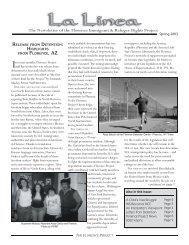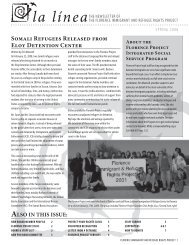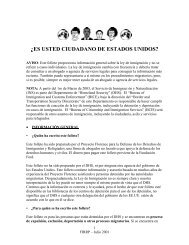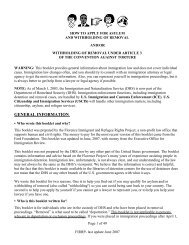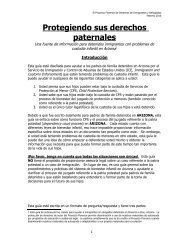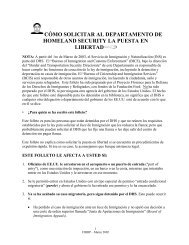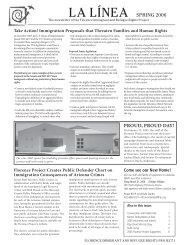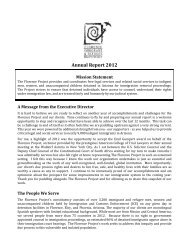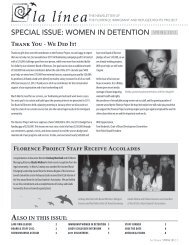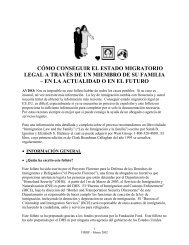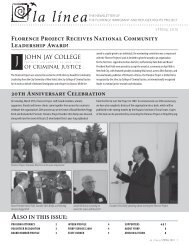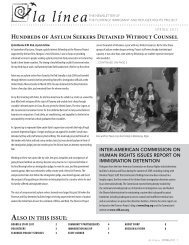quick reference chart and annotations for determining immigration ...
quick reference chart and annotations for determining immigration ...
quick reference chart and annotations for determining immigration ...
You also want an ePaper? Increase the reach of your titles
YUMPU automatically turns print PDFs into web optimized ePapers that Google loves.
Immigrant Legal Resource Center, Florence Immigrant <strong>and</strong> Refugee Rights Project,<br />
Maricopa County Public Defender August 2012<br />
3. Pretending to be, or assuming a false identity of, an employee or a representative of some person or<br />
organization with the intent to induce another person to provide or allow access to property. This<br />
paragraph does not apply to peace officers in the per<strong>for</strong>mance of their duties.<br />
B. Criminal impersonation is a class 6 felony.<br />
Crime Involving Moral Turpitude (CMT): May be divisible. A1 <strong>and</strong> A2 are CMTs due to the<br />
fraud element. A3 ought not to be held a CMT because falsely identifying oneself with no intent to<br />
obtain something of value has been held not to constitute a CMT by the Ninth Circuit. See Blanco v.<br />
Mukasey, 518 F.3d 714 (9th Cir. 2008). Since providing or allowing access to property is not necessarily<br />
something of monetary value or otherwise “tangible,” a conviction under A3 should not be considered a<br />
CMT. However, in practice, many <strong>immigration</strong> judges will still find this to be a CMT.<br />
Aggravated Felony: Yes, if the loss to the victim or victims exceeds $10,000, regardless of<br />
whether the amount of loss appears in the record of conviction. See 8 USC §1101(a)(43)(M); Nijhawan v.<br />
Holder, 129 S. Ct. 2294 (2009). Regarding proving a loss exceeding $10,000, see Note: Fraud.<br />
52. Taking Identity of Another Person or Entity, ARS 13-2008<br />
A. A person commits taking the identity of another person or entity if the person knowingly takes,<br />
purchases, manufactures, records, possesses or uses any personal identifying in<strong>for</strong>mation or entity<br />
identifying in<strong>for</strong>mation of another person or entity, including a real or fictitious person or entity, without<br />
the consent of that other person or entity, with the intent to obtain or use the other person's or entity's<br />
identity <strong>for</strong> any unlawful purpose or to cause loss to a person or entity whether or not the person or entity<br />
actually suffers any economic loss as a result of the offense…<br />
E. Taking the identity of another person or entity is a class 4 felony.<br />
Summary. While there are strong arguments that a conviction <strong>for</strong> Taking Identity should not be<br />
a CMT, many <strong>immigration</strong> judges in Arizona are currently finding that it is. The Ninth Circuit has held<br />
that falsely identifying oneself to a police officer is not a CMT; there<strong>for</strong>e, <strong>immigration</strong> counsel may have<br />
stronger arguments that § 13-2008 is not categorically a CMT since the elements of the Cali<strong>for</strong>nia <strong>and</strong><br />
Arizona statutes are similar. See Blanco v. Mukasey, 518 F.3d 714 (9th Cir. 2008). In terms of<br />
aggravated felony designations, the statute is divisible because it covers an extremely broad range of<br />
conduct. It doesn’t necessarily involve writing (required <strong>for</strong> the aggravated felony <strong>for</strong>gery), property<br />
(required <strong>for</strong> theft), or money (required <strong>for</strong> fraud). It seems to include offenses such as giving a false<br />
name to the police to avoid a warrant; using someone else’s social security number to get a job; person<br />
using a fake ID to prove he’s 25 to rent a car. (Use of fake ID <strong>for</strong> access to alcohol is specifically<br />
excluded by recent amendment; ARS § 13-2008(D)). If a person pleads to the language of the statute, the<br />
government will not be able to establish sufficient facts <strong>for</strong> an aggravated felony.<br />
Crime Involving Moral Turpitude (CMT): A very vague record of conviction may<br />
prevent this from being a CMT. See Tijani v. Holder, 628 F.3d 1071, 1078 (9th Cir. 2010) (“identity theft<br />
is a crime that may not involve fraud”). The minimum conduct to violate the statute is that lawfully<br />
obtained in<strong>for</strong>mation must be used without the other person’s consent with the intent to use the<br />
identity <strong>for</strong> an unlawful purpose. For example, an 18-year-old might use his older brother’s identification<br />
to get a job transporting liquor in violation of A.R.S. §4-244, someone who doesn’t have a social security<br />
number might use someone else’s to get a job, or a man might use a relative’s identification to purchase<br />
an appliance without having his credit rating checked, where he intends to timely complete payment <strong>for</strong><br />
the appliance. However, counsel should assume that <strong>immigration</strong> judges will find this to be a CMT.<br />
Arizona Criminal Chart with Explanatory Endnote – August 2012<br />
65



